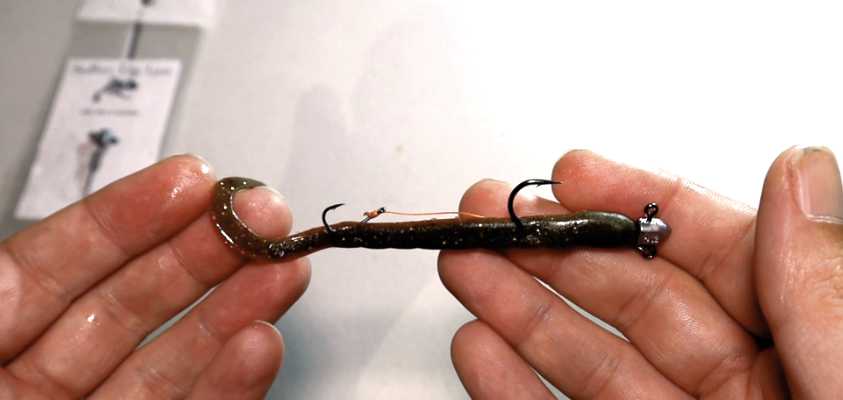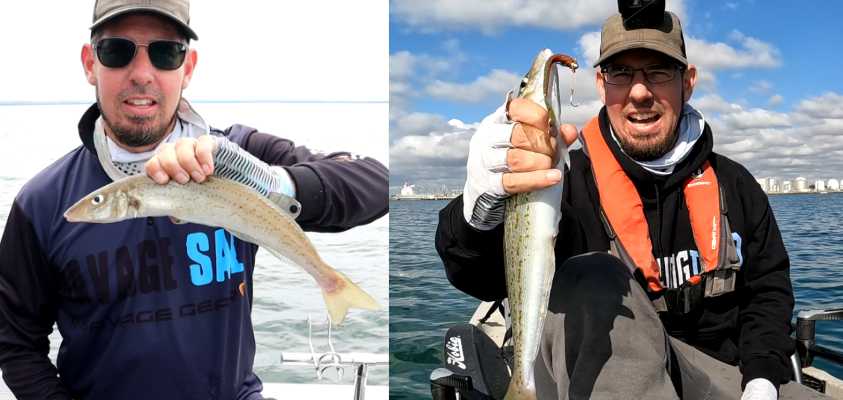Welcome to How to catch whiting on soft plastics. Most anglers still target King George Whiting with bait. It may surprise you, but they also love soft plastics. It’s a great way to target King George Whiting, it’s fun and requires less gear and less preparation. For a small slender fish whiting hit soft plastics surprisingly hard and it’s an enjoyable experience when using light spin gear. It’s also great not having to worry about buying bait, berley, or having smelly hands from touching bait too.
There are some real key fundamentals to catching whiting on soft plastics consistently. These key things are all about your setup and technique.
Watch our detailed video on how to catch whiting with soft plastics
The testing phase | Understand King George Whiting and soft plastics
For quite a while I was testing a range of soft plastics on whiting. I was getting heaps nibbles and hookups however my catch rates were low. I could tell after extensive testing that whiting were happy to commit and strike at the soft plastic however, they would only bite the soft plastic halfway up and miss the hook resulting in a lost catch. On most occasions the whiting was hanging onto the bottom half of the soft plastic and would let go after a few seconds or as you brought it boat or kayak side.
The key thing to understand when targeting whiting with soft plastics is that they have very small mouths. It can be very challenging to have consistent hook-up rates when using standard jig heads because they will often suck in the soft plastic but not fit the hook point of the jig head in their mouth. This idea got me working on concepts and designs to solve this problem and working with local fishing manufacturers to design viable solutions for this problem.
Whiting jig head setup solution
My final concept was to use a standard jig head but to customize it with an additional eyelet so you could run a small stinger hook roughly 8 cm below the main hook of the jig head. We tried this using multiple different jig head designs and also different jig head weights.
We have had the most success by far by using stinger or assist hooks when using worm imitation soft plastics like 4-inch turtleback worms. Rigging the soft plastic on straight then specifically pining the small assist hook 6 to 8 cm below the main hook. The best weight to date has been 1/12 which has a great sink rate especially when fishing in low tidal water sub 6 meters deep. ( of course, in tidal waters and deeper areas this can be significantly heavier ). This technique has been so successful that we had jig heads custom made which includes an additional eye on the jig head specifically to tie the line to support that additional assist hook.

Best Whiting Soft Plastics
Whiting love soft plastics that resemble worms, crabs, and yabbies. They will also take standard small soft plastics including 2.5 inch grubs and paddle tails. The standout soft plastics in our testing have included.
- Berkley 4 inch turtleback worms
- Berkley fat hollow sandworm
- Berkley Crabbie
- Munros 4 inch zip tail worm
- Zman 2.5 inch gruz
- Prolure live Yabbie
The worm imitations were the standout. You can use the smaller soft plastics like the 2.5 inch grubz and crabs but they won’t require an assist hook providing you get the jig head hook size correct.
How to work soft plastics to catch whiting
once you have the right jig head and the right soft plastic which has been rigged up properly then you are ready to cast and start working your soft plastic. The reality is the action isn’t much different when targeting whiting as opposed to targeting flathead or snapper. You simply cast and let the soft plastic sink to the bottom. Then have lengthy pauses and some lifts and twitches. Anglers often go wrong by working the soft plastic too fast. You need to give the whiting plenty of chance to take the plastic and remember the plastic will naturally be working in the water and omitting scent so many catches will come when the plastic is just sitting on the bottom.
Light Spin Gear setup for Whiting
We would recommend a 1-4, 2-4, or 2-5 kilo spin rod. Paired with a 2000 or 2500 size reel spooled with an 8 lb braid. Finished with 1 rod length of 8lb fluorocarbon leader. Ideally, the spin rod will be fast action with a stiff rod tip so you can stay in contact with your soft plastic at all times. Also, to feel the nibbles through the blank and set the hook at the right time.
Having the right gear is key to catching these fun and great-tasting fish consistently.
Identifying Good Grounds to catch whiting
King George Whiting love shallow ground with thick reefs, weed, and sand holes. Often, they will school up in these sand holes. So, identifying them can make a big difference to catch rates. A key thing with whiting is to keep moving until you find them. This can be done by drifting on calm days or anchoring and moving every 15 minutes until you find them. This is typical of whiting fishing however when you find them you will know as the action will be frantic.
BECOME A FISHINGMAD MEMBER & UNLOCK ACCESS TO
Workshops | Giveaways | Podcasts | Competitions | Reports | Maps | GPS Marks | Rigging Tutorials | Sounder School | Exclusive Footage | Tackle Talks | Gear Guides | Kayak Club | Much More
Thanks for reading How to catch whiting on soft plastics. if you have any suggestions font hesitate to let us know at enquiries@fishingmad.com.au we hope this article helps you with your bream fishing. Feel free to visit the FishingMad YouTube channel which has countess videos of us catching bream with these lures. Or the FishingMad how to fishing guides for more help.



